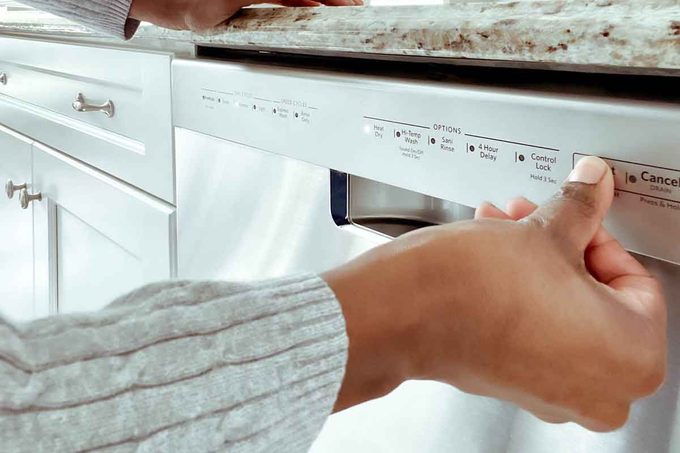The typical home uses about 11,000 kilowatt hours (kWh) of electricity a year, according to the U.S. Energy Information Administration. The washer and dryer, refrigerator and dishwasher take up 20 percent of the average home’s overall energy usage. Making small changes in how and when you use your appliances can make a big difference in your overall energy bill.
First Steps to Energy Efficient Usage
First, know your appliances. “When it comes to energy consumption, your water heater, clothes dryer and refrigerators are your electricity hogs,” said Joel Worthington, president of Mr. Electric, a Neighborly company.
In the 1990s, federal efficiency standards required household appliances such as the dishwasher, water heater and clothes washer to use less electricity and water. As a result, Energy Star appliances meet those standards while performing just as well, if not better, than their predecessors.
In many older homes, appliances have been upgraded but the electrical system has not. Your home wiring may need to be updated and possibly evaluated by a professional if:
- Lights dim when an appliance starts a cycle;
- Circuit breakers or fuses trip often;
- You use extension cords because there are too few outlets to operate appliances.
“When you look at your home’s overall electrical system, making sure it is functioning properly and contains the correct wiring and receptacles to power all your appliances is paramount,” Worthington says. “Getting your home’s electrical system checked is Step One in ensuring energy efficiency.”
Expect to pay around $300 to hire an electrician to install or repair outlets, and $2,000 to $6,000 to replace an electrical panel and install new wiring.
Least Efficient Cycle for the Clothes Dryer
For a more energy-efficient clothes dryer, consider changing the settings depending on the type of fabric in the load. Many people use the highest heat setting, often labeled the cotton cycle, all the time because they think it will dry laundry the fastest.
“Rather than opting for the highest heat setting, you could opt for either normal dry, or even delicate,” says Ron Shimek, president of Mr. Appliance.
To further save energy, set the automatic time shut-off for five to 10 minutes less than a full cycle. If you typically set the dryer for 60 minutes, reduce it to 50.
Another option: If the towels or clothing are still slightly damp at the end of a normal or delicate dry cycle, instead of running the dryer another ten minutes to finish, consider hanging up the clothes.
“You can install hanger rods in your laundry room, (hang them) on unused closet door space, or even create an outdoor clothesline,” Shimek said. “By cutting down the amount of time you are using the clothes dryer, you will be operating more efficiently.”
Least Energy-Efficient Refrigerator Cycle
A refrigerator uses lots of energy to keep the contents cool and produce perfect cubes of ice. The refrigerator’s heat pump cycle pulls heat away from the area you want to cool. Optimize the appliance’s function to ensure the cycle is running at its most energy-efficient level.
- Clean the coils at least once a year with a vacuum or duster.
- Keep plenty of airflow behind the fridge by leaving a good inch of room between the wall and the back of the appliance.
- Check the temperature settings regularly to ensure it is running at an optimal 40 F, according to the Food and Drug Administration.
- Organize food so that air flows around the sides and back of the interior of the refrigerator.
- Inspect door seals for cracks or tears and repair them immediately.
If these small changes don’t make a difference, you may need to call a professional.
“A huge efficiency zapper is an appliance running that needs repairs,” Shimek said. “There are many troubleshooting steps you can perform yourself. But ignoring an appliance’s need for professional repair is a definite way to burn unnecessary energy, and generate extra frustration.”
The Dishwasher Heat-Dry Cycle

The heat cycle on a dishwasher eats up the most energy. Skip this least energy-efficient heat or sanitize cycle for regular loads and the dishes will still come out clean.
The detergent in the dishwasher and the high-pressure water lift germs and bacteria off lightly soiled dishes. The high-temperature rinse and steam in the sanitize cycle further cleans and removes bacteria from the dishes. The heat-dry or sanitize option can extend the load cycle by up to 30 minutes, eating up more electricity. Everyday dishes can be cleaned well by hand, and it’s smart way to save energy.
Modern dishwashers use less water and heat than those built just 10 years ago. An older model dishwasher may run through 10 gallons of water per cycle. Today’s Energy Star dishwashers use around three gallons of water and five to 40 percent less energy per cycle.
For maximum benefit per cycle, rinse off large clumps of food and don’t overload the dishwasher so powerful sprays of water can’t circulate. Avoid using the rinse-hold cycle for anything but truly heavy and dirty dishes, such as baked-on pots and pans. The rinse-hold cycle can use up to seven gallons of hot water.
The Clothes Washer Hot Water Cycle
Clothes washers are like dishwashers in that 75 to 90 percent of the energy used heats the water via the water heater. But with newer washers, you don’t need as much hot water.
Longer, faster spin cycles in modern washers allow the machine to remove dirt with cold water rather than hot. And cold-water detergents with enzymes remove dirt and grime best without the hot water cycle. The energy-saving choice? The cold water cycle.
Article source here: Least Energy-Efficient Cycles for Your Appliances


No comments:
Post a Comment